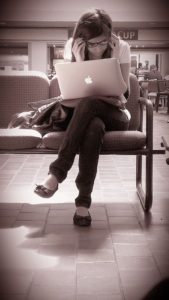Sitting correctly at a computer
Sitting correctly at a computer is the same as standing correctly and walking correctly.
It is all about the pelvis and the lower back.
My usual statement “it is all about the psoas” applies as well because nothing happens in the pelvis that doesn’t involve the psoas.
The position of the pelvis determines everything that happens above and below with the legs, trunk, and arms.
The position of the pelvis and the ability of the psoas to do its thing are intricately linked.
Our lower back is referred to anatomically as the lumbar spine.
This part of the spine, between the pelvis and the rib cage, should always have a slight curve.
This curve, which should be very small or gentle in its slope, is what sets human beings apart from all other mammals.
It is the lumbar curve that allows us to be upright and walk on two legs.
The lumbar curve is created by the psoas as we come up to stand and the psoas pulls the bones of the lumbar spine forward.
Sitting correctly at a computer requires the help of the psoas which, along with the hip bone, acts as a pulley system in the body supporting the upright position of the spine.
When we lose the curve we lose all of our upright support. This is the key to sitting, walking, and standing.
Presumably, you are sitting at your desk reading this (though I am a big fan of the standing desk).
Put your hand on your lower back.
Is it curved in or rounding back?
Where is the weight on your pelvis?
If I had to guess, your lower back is rounding backward and the weight of the pelvis is slightly behind the sit bones.
Stick Out Your Butt
 Can you do the opposite?
Can you do the opposite?
Try to stick your butt out.
This will help to move your weight on top of the sits bones.
This should also tilt your pelvis oh so slightly forward and move your lumbar spine into a gentle curve.
It is as simple as that anatomically.
Everyone to some degree or another should be able to do this with their bones and feel the positive effect.
Try doing this over and over. Stick your butt out and then tuck your pelvis. And then find the place that you think is best and try to stay there.
The main problem with this is that we are more than bones.
We have muscles that are habitually tight and resist the changes we would like to make to our skeleton.
While most people should be able to find their way to this correct sitting position, tight muscles will pull you back to where you were.
It is just a matter of time.
Sitting correctly at a computer requires length in the back and spinal muscles that work hard to pull you back into your habitual position.
Exercises to lengthen and strengthen the back combined with better alignment of the pelvis is what we need most.
This is what will allow us to sit correctly at a computer.

